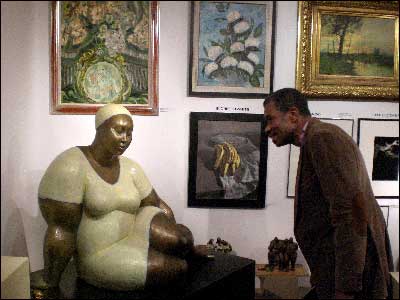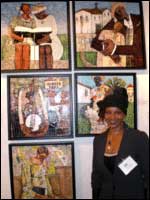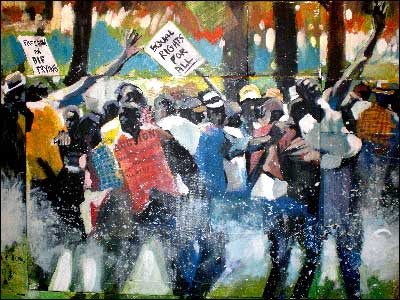
Though Nnamdi Okonkwo was displaying his sculpture at America’s top black fine arts show, he criticized the event and its audience — even the very idea that “black art” exists.
“I have some problems with shows like this,” said the Nigerian-born sculptor, who was showing his work at the annual Black Fine Arts Show in New York in February. “The majority of people who come here are looking for art that reflects African American history. History becomes part of judging whether a picture is good.”
Okonkwo’s work probably doesn’t fit easily into that story. His bronzed figures of plump females represent the veneration of womanhood, he explains on his website, and were inspired by his wife and mother, not by black identity issues. “Ninety-nine percent of what I do as far as exhibiting my work does not concern [being black],” he said.
The success of Barack Obama’s presidential campaign has rekindled all kinds of debates over race, and not just in politics. Headlines and TV broadcasters ask:
“Is Obama black enough?”
“Is America ready for a black president?”
“Does race matter anymore?”
A parallel debate in the arts sometimes leaves black artists feeling pressured to produce work that reflects African American history and identity.
“There is no such thing as ‘black art,’” argued Josh Wainwright, the producer of this year’s Black Fine Arts Show, the major annual U.S. event showcasing art by Africans and African Americans. The show was begun in 1997 to address complaints by black artists that the art world marginalized and ignored them.

Asked why there were so few black artists represented in major art galleries, Wainwright, who is black, said he had “a pretty good idea why, and it’s called racism.”
Yet others argue that categorizing the work of African and African American artists as black art is a matter of practicality and salability.
“This is an audience genuinely interested in what African American artists are producing,” said Tony Decaneas, owner of Panopticon Gallery of Photography in Boston. “But as a dealer, I’m torn between putting up work that people will buy, and displaying works that have integrity and are fresh.” Human interest pieces and photos of recognizable figures sell best, but he tries to balance those with lesser-known work.
“There is a disconnect, even in the art world … for black artists who are not necessarily putting out what black people might want to see,” said writer and cultural critic Frank León Roberts. Yet, he said, white audiences are “eating up” avant-garde black art often ignored by black audiences.
The expense of buying original art could be a factor. “I think that, as a community, black audiences would gravitate towards works with black actors and themes related to the black community, so long as it’s actually affordable,” Roberts said.
Sometimes art, music, and theater produced by black Americans “is reduced to the question of how can markets best facilitate getting black butts into seats to watch black people perform black things and black comedy,” said Tavia Nyong’o, a professor of performance studies at New York University. “That then turns blackness into a commodity.”
Painter April Harrison considers her art an expression of personal memories and universal emotions, not black identity.
“My paintings are about love and spirituality,” she said. “My main theme is family bonding, taking you back to a time when love meant something.” Harrison’s work is dreamy and colorful, often depicting children, family members embracing, and other scenes from her home in Simpsonville, South Carolina. Her gallery show “Southern Comfort/Southern Discomfort” in 2007 juxtaposed her images of black Southerners with those by painter Charly Palmer.
Palmer’s paintings are full of sorrow and frustration, anger and hope: several incorporate signs from the segregation era, like “Waiting Room for Whites Only” and “Entrance Colored.”
“I don’t think there is any type of ethnic art,” Palmer said in a phone interview from his home in Atlanta. “Our subject matter just happens to be African American.” The impulse towards labeling things “black art” is a sign that “American society wants to put all artists in a category.”
“When it comes to my art, I paint African Americans, but I’m really painting the American experience,” he said. The idea of “black art” is a sad legacy of racism in the United States. “It goes back to the history of America, when Europeans brought in the Africans as slaves,” he said. “The need for separation has been there from the beginning.”

- Follow us on Twitter: @inthefray
- Comment on stories or like us on Facebook
- Subscribe to our free email newsletter
- Send us your writing, photography, or artwork
- Republish our Creative Commons-licensed content

